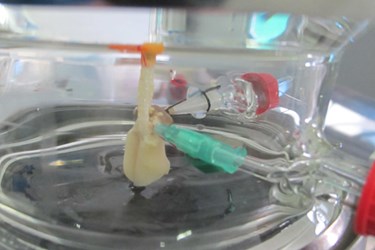Researchers Create Miniaturized, Artificial 3D Human Lung

Researchers in Germany have created a realistic 3D model of a human lung that could significantly improve the field of lung cancer treatment.
In particular, the new artificial lungs could provide a more effective way to test lung cancer drug treatments — potentially serving as a substitute for animal testing — while also making possible a more intensive way of studying how cancer cells behave as they metastasize.
“Animal models may be the best we have at the moment, but all the same, 75 percent of the drugs deemed beneficial when tested on animals fail when used to treat humans,” Heike Walles, head of the Würzburg-based Regenerative Technologies for Oncology program at the Fraunhofer Institute for Interfacial Engineering and Biotechnology IGB, said in a recently published press release. “We’ve developed an innovative 3D test system that allows us to superbly simulate what happens in the human body. Our plan is for this system to replace animal tests in the future.”
The new 3D lung is created from lung cancer cells growing on tissue. A bioreactor is then used to simulate the movements of breathing as well as pump nutrients throughout the organ in a manner similar to natural lung tissue. Researchers can control different aspects of the model such as the speed at which the lung breathes or how deeply it breathes. With a volume of half a cubic centimeter, the model lungs are about the same size as a sugar cube.
In early tests, researchers report that the model lungs have similar reactions to lung cancer drugs as those of actual patients’ lungs — a sign that indicates they could possibly be used to test new drugs in the future.
Additionally, researchers say they could also begin building model lungs for individual patients as a way of testing which specific drugs or combinations of drugs might provide the most effective, individually tailored treatment.
Moving beyond drug testing applications, the new model lungs could be used for studying the behavior of metastasizing cancer cells.
“As metastases can’t be examined in animals — or in 2D models where cells grow only on a flat surface — we’ve only ever had a rough understanding of how they form. Now for the first time, our 3D lung tissue makes it possible to perform metastases analysis,” said Walles. “In the long term, this may enable us to protect patients from metastases altogether.”
Image Credit: Fraunhofer IGB
